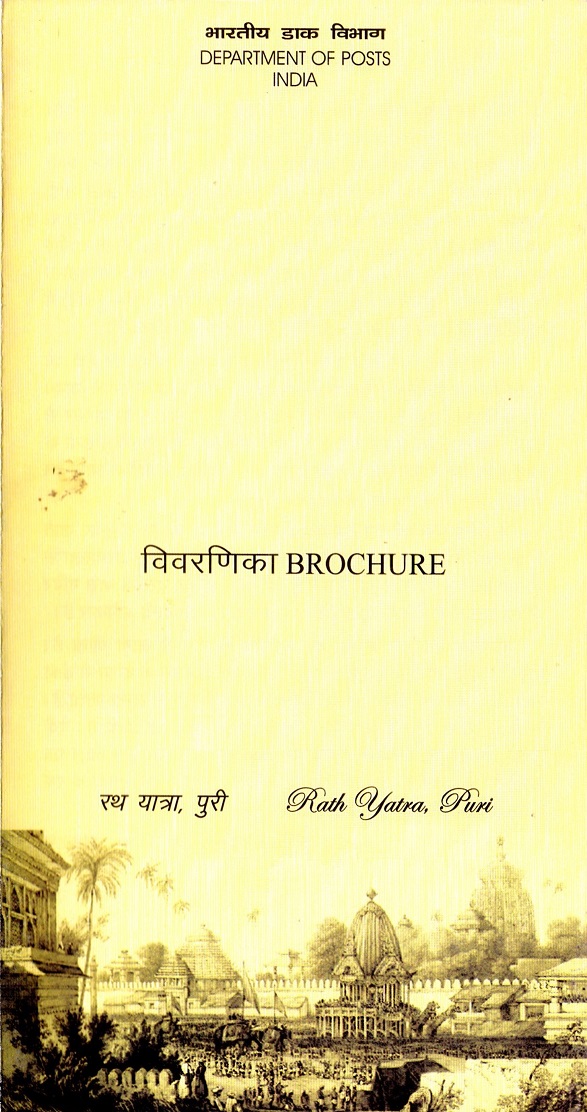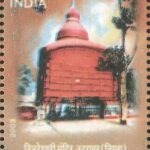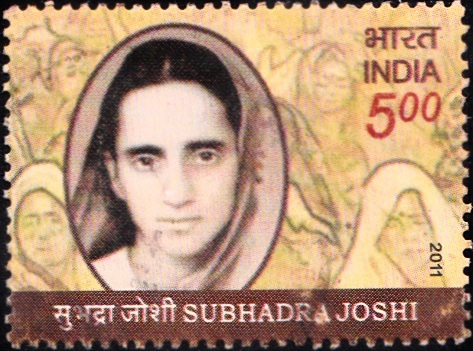
Rath Yatra, Puri
A Souvenir Sheet consisting of 1 no of commemorative postage stamp on Ratha Jatra, a Hindu festival associated with Lord Jagannath held at Puri, Odisha, India :


 Issued by India
Issued by India
Issued on Jul 12, 2010
Issued for : India Posts is happy to issue a commemorative postage stamp on the Rath Yatra.
Credits :
Stamp & FDC : Sankha Samanta
Cancellation : Alka Sharma
Type : Miniature Sheet, Mint condition
Colour : Multi colour
Denomination : 500 Paise
Stamps Printed : 0.8 Million
Miniature Sheets : 0.4 Million
Printing Process : Photogravure
Printer : India Security Press, Nasik
About :
- The world famous Car Festival of Puri popularly known as ‘Rath Yatra‘, ‘Gundichi Yatra‘ and also ‘Ghosla Yatra‘ – is the biggest and the grandest car festival of all, having given the word “juggernaut“, to the English language. The festival commemorates Lord Jagannath‘s (Lord Krishna) annual visit to his aunt’s home, alongwith his brother Balabhadra and sister Subhadra from his abode (main temple) to Gundicha Temple where they remain for nine days. This mammoth and spectacular Rath Yatra is held on ‘Asadha Sukla Dwitiya‘ (June-July) every year at Puri, the temple town in Orissa. It is both a religious and a cultural event.
- On the Rath Yatra day, the three presiding deities, decorated richly are taken out from the temple precincts in an elaborate ritual procession to their respective chariots in a traditional ceremonial manner, known as ‘Pahandi‘, and pulled through the streets of Puri to Gundicha Temple by thousands of pilgrims who congregate at Puri for this annual event from all over the country and abroad.
- These chariots are made every year with the wood specified for the purpose, which is brought customarily from the ex-princely state of Dasapalla by a specialist team of carpenters who have hereditary rights and the privilege of making the chariots resembling the temple structures.
- The chariot of Lord Jagannath is known as Nandighosh. It has 16 wheels and the colours of the fabrics that cover the roof of the chariot are red and yellow. The chariot of Lord Balabhadra is known as Taladhwaja. It has 14 wheels and the colour of the fabrics is red and green. Devi Subhadra‘s chariot is called Deva Dalan/Darpa Dalan and is decorated with red and black fabrics. Sudarshan is seated by the side of Subhadra in her chariot.
- Madanmohan, a representative deity of Jagannath sits in the chariot of Lord Jagannath. Two other small idols of Ram and Krishna take their seats in the chariot of Balabhadra. The three chariots are moved to a temple known as ‘Gundicha Ghar‘ at a distance of about 3 kms from Jagannath Temple. The chariot of Balabhadra is pulled first followed by those of Subhadra and Jagannath.
- The ninth day marks the return Car Festival day when the chariots along with the deities are brought to the Lions gate area of the Jagannath Temple. An important ritual performed on the 5th day (starting from and including the day of Car Festival) is known as ‘Hera Panchami‘, when Goddess Laxmi is believed to proceed to Gundicha Ghar to see her Lord. On the evening of the 10th day the deities are adorned with gold ornaments and dressed gorgeously in their respective chariots parked in the Lion’s gate area. On the same day another ritual called ‘Hari Sayan Ekadasi‘ is performed. On the 12th day of the bright fortnight, another important ceremony known as ‘Adharapana Bhog‘ (a sweet-drink) is offered to the deities. On the evening of the following day, the deities are taken into the temple in a traditional procession amidst a gathering of thousands of devotees.
- After the festival, the chariots are broken and bits are used for firewood in the kitchens or sold to pilgrims as relics. New chariots are made each year according to the specifications contained in the temple’s manuals. The assembled multitude from all over India, the thunder of music and percussion and the decorated chariots provide an unforgettable experience, to the believer and the bystander.
- A glimpse of Lord Jagannath on the chariot is considered to be very auspicious and saints, poets and scriptures have repeatedly glorified the sanctity of this special festival. The sanctity of the festival is such that a touch of the chariot or even of the ropes with which these are pulled is considered enough to confer the results of several pious deeds or penance for ages. In fact, on this occasion, the chariot, the wheels, the grand avenue, all are believed to become one with Lord Jagannath himself.
- In the words of Kathopanishada “Atmanam rathinam viddi sareeram rathamevatu Buddhim tu saarathim viddhi marah pragrahamevacha“, i.e., “The body is the chariot and the soul is the deity installed in the chariot. The wisdom acts as the charioteer to control the minds and thoughts”. The Rath Yatra is thus a symbol of man’s journey through life as a spiritually evolving being.
- Text : Based on the materials provided by the proponent and downloaded from the internet.








[…] an imposing spire. It carries the richness of the Kalinga style of architecture and the Lord’s “Yatra” is an imposing […]
[…] inside for darshan. And on the third day the new deities emerge from the temple for the biggest Chariot Festival. The Nabakalebara draws millions of people from across the world to Puri, and is one of the biggest […]
[…] current location to treat sick pilgrims enroute to Puri & back during the famous Car Festival (Ratha Yatra) of Lord […]
[…] Sambalpuri Bandha (Ikat) work or Sambalpuri work contains the warp and the weft tie-dyed before weaving. This is produced in Sambalpur, Balangir, Bargarh, Boudh and Sonepur Districts of Odisha. The traditional garment has the motifs like Sankha (conch-shell), Chakra (wheel), Phula (flower). These have deep symbolism with the native Odia colours i.e., red, black and white representing Odia culture along with the colour of the face of Mahaprabhu Shree Jagannatha. […]